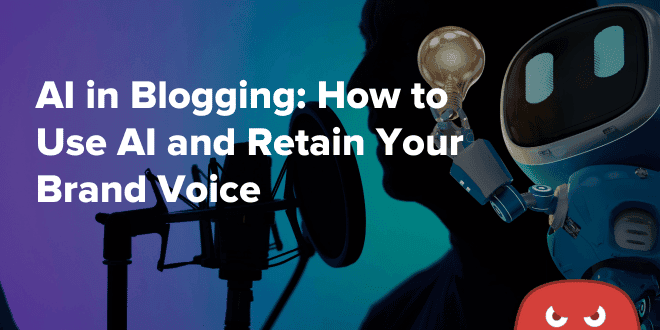
AI in Blogging: How to Use AI and Retain Your Brand Voice
The Top Ways AI Can Assist with Content Creation
When it was first introduced, some assumed generative AI (GAI) was capable of creating amazing articles from scratch based on a single prompt. They thought they’d pull up a program like ChatGPT, ask it to write the best article on digital marketing ever, and then immediately reign from the #1-ranked position on Google.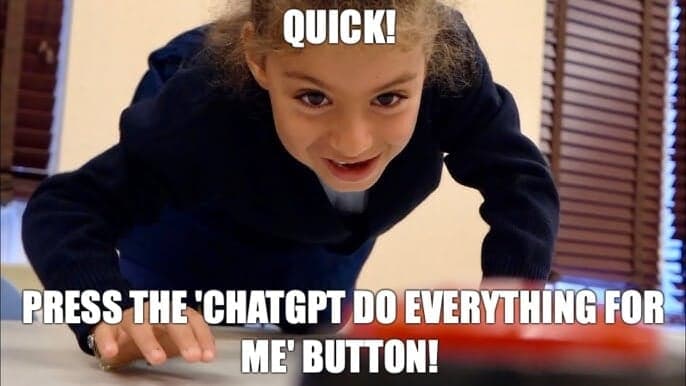 Now that GAI tools have been readily available for a few years now, we know that it’s not that easy.
In fact, AI prompting has become a desired skill of its own, as it takes a lot of nuance and understanding to write prompts that yield the results you want. Many companies now employ prompting engineers to ensure their AI programs reflect their brand’s voice and values.
Also, GAI tools aren’t the best at writing entire pieces of content from scratch.
Instead, you’ll find more success with a piecemeal approach – where you use AI to assist with different phases of the writing process – instead of having the tool create an entire article at once.
In particular, AI content tools are most effective at:
Now that GAI tools have been readily available for a few years now, we know that it’s not that easy.
In fact, AI prompting has become a desired skill of its own, as it takes a lot of nuance and understanding to write prompts that yield the results you want. Many companies now employ prompting engineers to ensure their AI programs reflect their brand’s voice and values.
Also, GAI tools aren’t the best at writing entire pieces of content from scratch.
Instead, you’ll find more success with a piecemeal approach – where you use AI to assist with different phases of the writing process – instead of having the tool create an entire article at once.
In particular, AI content tools are most effective at:
- Aiding with keyword research
- Brainstorming topic ideas, headlines, and subheadings
- Overcoming writer’s block
- Creating article outlines
- Getting a first draft ready for further edits
Aiding the keyword research process
Chatbots and other GAI programs are extremely helpful for enhancing your keyword research process, which is always the first step when developing content that you want to rank well on Google (and other search engines). The main advantage here is that AI tools can process vast amounts of online data related to your target audience and then suggest relevant keywords. More often than not, these are high-potential keywords that other websites haven’t considered yet, giving you the chance to be the first to rank for them. However, you should never use AI tools to conduct 100% of your keyword research. Instead, use them to brainstorm some creative ideas, and then use an official keyword planner tool (like our free option) to vet the metrics. Let’s view a quick example. First, let’s use ChatGPT to generate some unique keywords for the gardening niche: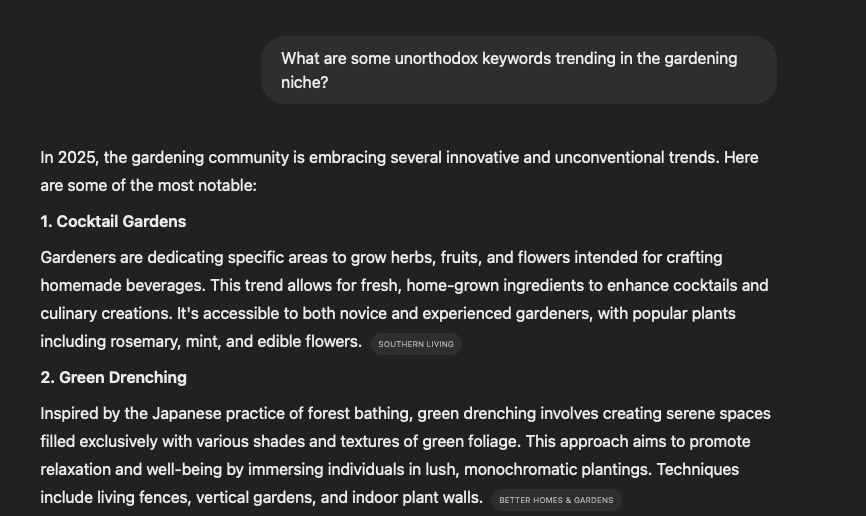 It lets us know that cocktail gardens are an innovative trend gaining traction with gardeners this year, which would be an interesting topic for an article.
However, let’s use our free keyword planner tool to verify if this is indeed true.
It lets us know that cocktail gardens are an innovative trend gaining traction with gardeners this year, which would be an interesting topic for an article.
However, let’s use our free keyword planner tool to verify if this is indeed true.
 Sure enough, the keywords cocktail gardener and gardening cocktails both have decent search volume and, more importantly, an upward search trend – meaning they’re both gaining popularity.
So, you could use AI to help you whip up an article on dedicating an area in your garden to grow herbs for cocktails (while incorporating the two aforementioned keywords).
This is just one simple example of how you can use AI to inform your keyword research process.
Sure enough, the keywords cocktail gardener and gardening cocktails both have decent search volume and, more importantly, an upward search trend – meaning they’re both gaining popularity.
So, you could use AI to help you whip up an article on dedicating an area in your garden to grow herbs for cocktails (while incorporating the two aforementioned keywords).
This is just one simple example of how you can use AI to inform your keyword research process.
Brainstorming ideas
Another way you can use AI to speed up the content creation process is to use it for brainstorming quick ideas. For example, coming up with enticing article headers can be a time-consuming, brain-wracking process at times. Not only do your headers have to be catchy and creative, but they also must contain SEO keywords without feeling awkward or out of place. Since AI never runs out of ideas, you can use it to spark your creativity when trying to come up with:- Article headers
- Subheadings
- Paragraphs
- Introductions
 Voila, now we have something to work with.
If you want even more options for brainstorming, you can ask ChatGPT to provide alternatives:
Voila, now we have something to work with.
If you want even more options for brainstorming, you can ask ChatGPT to provide alternatives:
 These are actually pretty good, but they’re a little bit long. Let’s ask it to write more headers but this time keep them under 60 characters:
These are actually pretty good, but they’re a little bit long. Let’s ask it to write more headers but this time keep them under 60 characters:
 As you can see, continuing to prompt AI is a great way to refine the tool’s output and get closer to the results you’re looking for. After three rounds of prompts, we have some excellent titles to brainstorm with (or use outright).
This is also the best way to overcome writer’s block. If you’re having a hard time putting words together, AI will provide you with a never-ending supply of ideas to get the ball rolling in your head.
Besides headings, you can use AI to brainstorm any type of idea you need, whether it’s a specific way to phrase a sentence or the right adjective you need for a subheading.
As you can see, continuing to prompt AI is a great way to refine the tool’s output and get closer to the results you’re looking for. After three rounds of prompts, we have some excellent titles to brainstorm with (or use outright).
This is also the best way to overcome writer’s block. If you’re having a hard time putting words together, AI will provide you with a never-ending supply of ideas to get the ball rolling in your head.
Besides headings, you can use AI to brainstorm any type of idea you need, whether it’s a specific way to phrase a sentence or the right adjective you need for a subheading.
Developing outlines for articles
The writing process is made 1,000% easier by working off an outline, but busy professionals don’t always have the time necessary to create them. For instance, many digital marketing professionals have to create content briefs for their writers, a process that often gets in the way of other, more pressing tasks. AI tools are amazing for speeding up this process, as you can create an actionable outline for an article within a few minutes using a tool like ChatGPT. As proof, here’s one for our cocktail gardening article: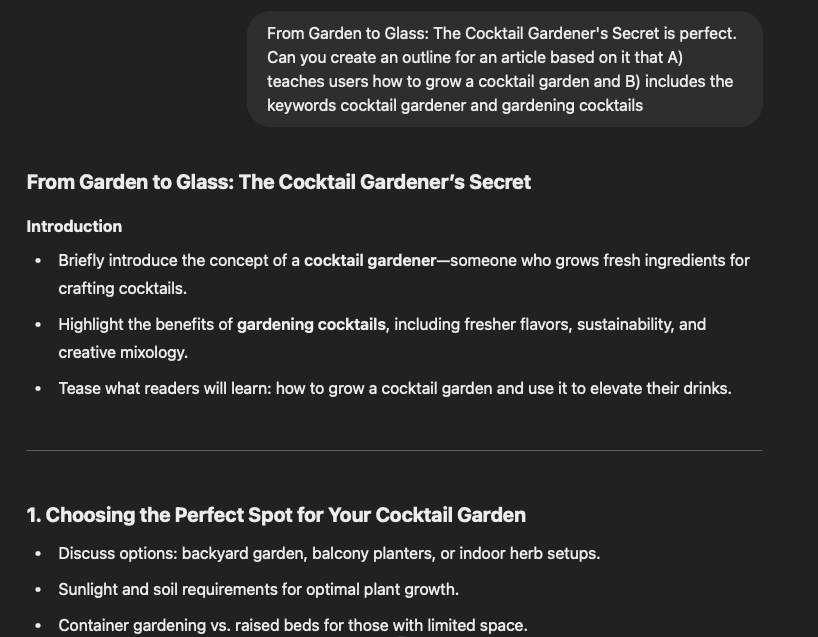 .
Based on a semi-detailed prompt, AI was able to put together a complete article outline for the topic, which would be perfect for a busy marketing professional. It even included a CTA (call-to-action) in the conclusion so that the article has the chance to generate leads and sales:
.
Based on a semi-detailed prompt, AI was able to put together a complete article outline for the topic, which would be perfect for a busy marketing professional. It even included a CTA (call-to-action) in the conclusion so that the article has the chance to generate leads and sales:
 Of course, this outline is pretty vanilla and lacks any noticeable brand voice, but we’ll get to that in a minute.
For now, it’s a suitable outline that you can tweak to add special instructions for your writer (like which service they should plug with a link in the CTA).
Of course, this outline is pretty vanilla and lacks any noticeable brand voice, but we’ll get to that in a minute.
For now, it’s a suitable outline that you can tweak to add special instructions for your writer (like which service they should plug with a link in the CTA).
Helping create a first draft for further edits
Lastly, AI tools will help you get a first draft going that you can edit later on. It’s imperative to not just use the first draft an AI tool generates because it will be:- Too generic
- Not authentic enough
- Devoid of original insights
- Lacking your brand voice
 As you can see, it’s pretty generic, but there are a few usable sentences here and there (the intro sentence is particularly strong).
Also, it still reads like an outline, as each section contains brief bullet points without much elaboration:
As you can see, it’s pretty generic, but there are a few usable sentences here and there (the intro sentence is particularly strong).
Also, it still reads like an outline, as each section contains brief bullet points without much elaboration:
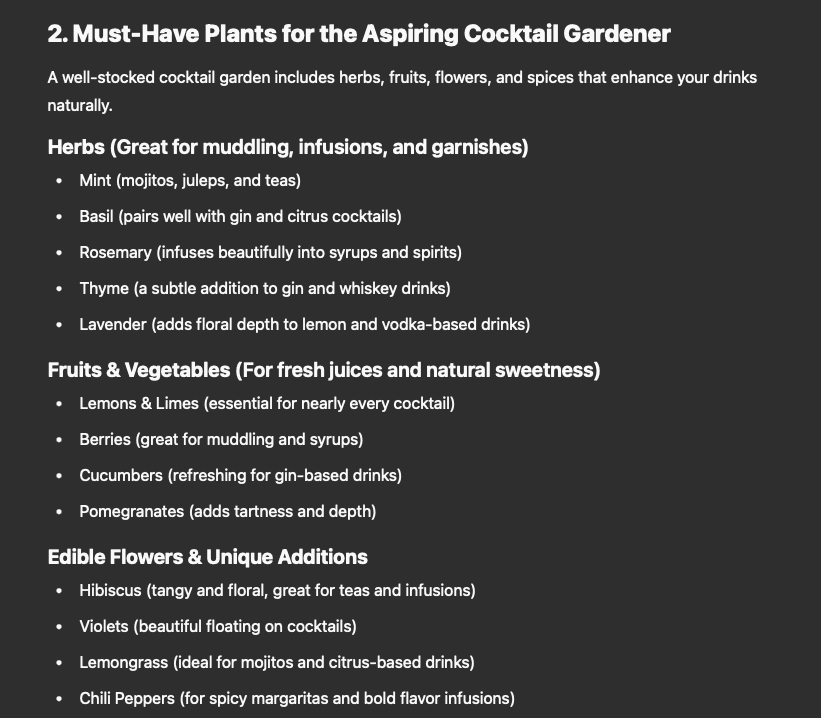 While this makes the article extremely readable, it’s thin on content and original insights. However, it makes an excellent starting point for a team of human editors, so it’s still worth having.
While this makes the article extremely readable, it’s thin on content and original insights. However, it makes an excellent starting point for a team of human editors, so it’s still worth having.
Maintaining Your Brand’s Voice When Using AI
Okay, now that we’ve used AI to knock out the basics, it’s time to add some heart to it. What type of content should you add to AI articles to make them more valuable to search engines and users? Using Google’s E-E-A-T acronym is an extremely helpful guide, especially the first two E’s (experience and expertise). The A stands for authoritativeness, and it refers to the strength of the backlinks pointing at a piece of content. The T, trustworthiness, is achieved by utilizing a strong combination of the other letters (experience, expertise, and authoritativeness). Therefore, the top two things you need to add to your AI-generated content are:- First-hand experiences
- Clear demonstrations of your expertise
Aligning AI content with your brand’s personality
Next, you need to ensure that the final product reflects your brand’s unique voice and personality, which will require some tweaking both from AI and your human writers. For example, I could have included specific instructions for brand voice when prompting ChatGPT to create content for the cocktail gardening article, but I kept it generic for demonstrative purposes. Currently, most GAI tools are able to create content in a variety of different tones and voices, which makes it easier to stay faithful to your brand when generating a first draft. Here’s an edited version of the intro to the cocktail gardening article that’s written in a more lighthearted tone intended to appeal to a younger crowd: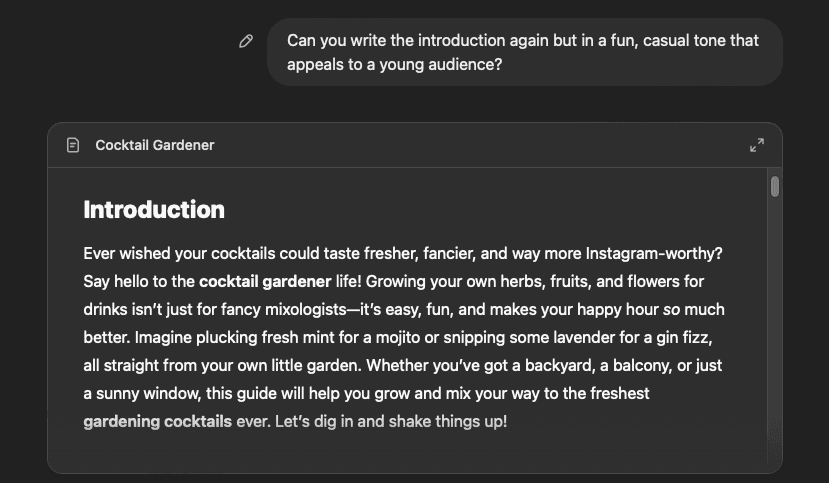 This would be more in line with your brand voice if you were catering to a younger audience that spends a lot of time on social media.
However, and this is a big however, you should always do a round of editing with human writers to ensure your brand voice is 100% accurate.
An AI tool will never fully understand your brand, and it can never truly speak for you. That’s why it’s crucial to add your own spin on everything that you generate with AI to remain true to your brand’s image. Remember, customers crave authenticity in today’s AI-dominated age, so do your best to add genuine insights to your content.
This would be more in line with your brand voice if you were catering to a younger audience that spends a lot of time on social media.
However, and this is a big however, you should always do a round of editing with human writers to ensure your brand voice is 100% accurate.
An AI tool will never fully understand your brand, and it can never truly speak for you. That’s why it’s crucial to add your own spin on everything that you generate with AI to remain true to your brand’s image. Remember, customers crave authenticity in today’s AI-dominated age, so do your best to add genuine insights to your content.
AI Content vs. Human-Written Content: The Pros and Cons
Now that you know how to achieve the best of both worlds by merging human writers with AI tools, let’s quickly examine the pros and cons of only using one or the other.AI content: advantages and disadvantages
As far as perks go, AI-generated content is all about saving tons of time and money. You can generate content with AI tools in literal seconds, which is invaluable for saving money and getting the most out of your time at work. AI tools are also powerful ways to boost your own creativity by providing candid suggestions for headers, topics, sentences, and paragraphs. On the negative side, AI tools aren’t able to provide first-hand experiences or original insights, two things that Google deems necessary to achieve high-quality content. Also, AI is limited in its ability to express humor and emotions, both of which are important for connecting with your target audience.Human-written content: advantages and disadvantages
Human-written content is basically the opposite of AI-generated content. On the beneficial side, content created by humans is often authentic and contains original insights (as long as the writer knows what they’re doing). Human writers are also far better at expressing humor and other emotions, making it easier to connect with audiences on a deeper level. This can foster strong brand loyalty amongst customers, so it’s crucial not to lose the human touch. The downside is that humans can’t create content at the lightning-fast pace that AI tools can. Humans are also susceptible to writer’s block, which can make content take even longer to create.Case studies: real-world examples of success with AI content
Before we wrap up, let’s look at a few instances where companies hit the sweet spot and found great success with AI-generated content. A Danish news outlet (TV 2 Fyn) discovered that the AI-generated headlines they were using resulted in a 59% increase in its click-through rates (CTR). They achieved this by using AI to generate headlines and then A/B testing them against human-written headlines. Once again, they used a combination of human and AI writing to achieve great results. The financial company Bankrate has also found SEO success using AI-generated content. For instance, this article on contribution margin is transparent about the fact that it was generated by AI and then edited by their publishing team to ensure quality: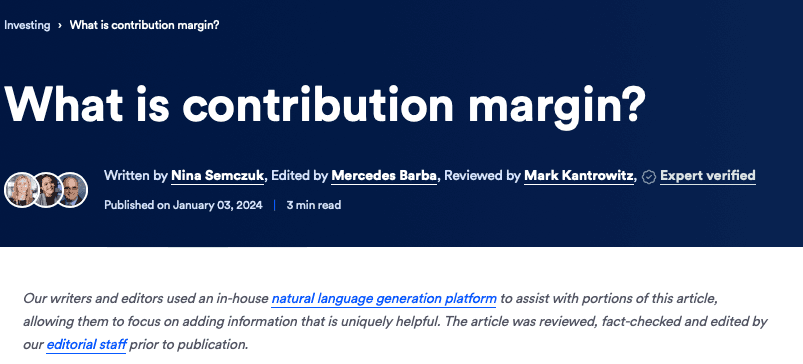 That didn’t stop it from ranking in the #2 organic position for a relevant keyword, though:
That didn’t stop it from ranking in the #2 organic position for a relevant keyword, though:
 These are two real-world examples that prove you can achieve impressive results by using GAI tools in your content creation process.
These are two real-world examples that prove you can achieve impressive results by using GAI tools in your content creation process.
Achieving the Right AI-Human Balance to Achieve Lasting Success
We’ve gone over a ton of stuff, so let’s recap:- Mass amounts of AI-generated content have caused users to crave authenticity from brands.
- Google does not have anything against AI-generated content, only content that’s low-quality.
- AI tools are best for brainstorming ideas and creating outlines.
- You should add first-hand experiences and original insights to AI-generated content to improve its quality and ranking ability.
- Don’t forget to edit each piece and add elements of your brand voice to maintain consistency with the rest of your content.
The author
Rachel Hernandez
description
Previous
How to Find New Topic Ideas and Create SEO-Friendly Content
Next
Can AI-Generated Content Rank on Google? The Truth About AI and SEO
Discussion
Comments
Louise Savoie
February 28th, 2025
Great read! It’s all about achieving the right AI-human balance—using AI as a helper, not a replacement.
